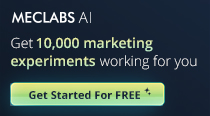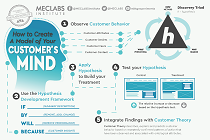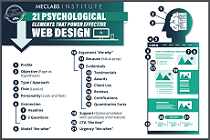
|
SUMMARY:
MarketingSherpa has spilled much ink over the years writing about Sales-Marketing alignment. Usually that means doing a better job of the handoff between Sales and Marketing…but there is still a hand off. ‘We’ll find interested people here in Marketing, but you folks over in Sales need to turn them into revenue.’ True success is a partnership, and marketers can play a key role in making sure those qualified leads actually become booked revenue. To help you do that, read on for a structured approach to address common roadblocks, re-engage prospects, and provide clear, actionable ideas to your sales team. |
Action Box: AI workflow can help do this with you
MeclabsAI can do it with you. Try the multi-agent workflow how to accelerate sales deals that have stalled (MeclabsAI is MarketingSherpa’s parent company).
Identify what is holding the deal back. Consult with your sales team or ask prospects directly where they encountered problems.
Let’s look at the Meclabs Conversion Sequence heuristic (from the parent company of MarketingSherpa), to get some ideas. While this heuristic became well known to help with landing page optimization, its core function is to help improve the probability of conversion.
And a sale is another type of conversion.
Two factors that reduce the likelihood of a conversion are friction and anxiety.
Friction is a psychological resistance to an element in the sales process. Here are some examples for a sales deal:
Anxiety is a psychological concern stimulated by an element of the sales process. Here are some examples for a sales deal:
Two things to note about these lists. First, these are just some general examples to get you and your team thinking about what issues your prospects may be having. Their real issues are likely very specific.
Like, ‘I want a new cloud solution so I don’t have to keep going to IT for content updated to our website. But my CTO told me that the last time we hosted content with a vendor they went out of business and we lost hundreds of hours of video footage from our sites. They had to set up new servers over the weekend and upload the content from magnetic tapes. So the CTO flat out refuses to agree to a cloud solution, and I can’t get budget approval if she’s not on board.’
At this point in the overall prospect journey, you’ve moved beyond broad one-to-many marketing and the Sales team should be engaged in one-to-one, very focused conversations. So you don’t just want a general understanding of the friction or anxiety stalling the deal, you want the exact, very specific reason.
Even once you get that reason, dig deeper. What is really behind it? Use an approach like the 5 Whys developed by Sakichi Toyoda – ask ‘why’ at least five times to drill down to the true root cause of the challenge.
“It is usually a change in priorities or something that is unforeseen that is leading to the reluctance. The important thing is to know whether anything has changed in the needs of the client since the last time you contacted him. I find that around 40 percent of the deals stall due to this. You must burrow in and probe the questions to get the whole picture and understand where things have changed,” advised Faraz Hemani, owner & CEO, Iron Storage.
Another thing to note is – some of these elements of friction or anxiety are internal to the prospect’s company. They may have nothing to do with your product, service, or company. Frustrating? Yes.
However, this is our role as marketers and salespeople. It’s to shepherd the ideal customer to the best solution for them. And sometimes that means helping them through their own internal issues. So support your champion with information (like case studies or conversations with other customers) or even bonus value (like a free project scoping exercise based on their internal IT ecosystem before the contract is signed).
Or offer them risk mitigation like risk-free trials or money-back guarantees to reduce decision anxiety and reduce commitment concerns.
Make sure your offer meets the customer's needs. As Hemani mentioned, things can change since the initial prospect became a sales-qualified lead. Or perhaps as the deal has progressed, more senior-level leaders have become involved for budget approval and are unaware of your company’s value proposition.
If you only focus on the logistical and contractual elements of the deal, you will only be discussing the cost to them. A total focus on cost will kill a conversion. So keep bringing the value back into the conversation to remind them (or in the case of new players involved in the deal, make sure they understand for the first time) the value of your product or service for each of them.
Since you are deeper into your relationship with the company or individual you want to sign as a client, you have a better understanding of their motivations. Use that knowledge – matched with the understanding of what friction of anxiety is derailing the deal – to re-present the value proposition with a tighter focus on their needs.
Frame your discussion around how your product eases the prospect’s very specific pain points that you now understand more deeply. Clearly state the benefits of your solution using concrete examples that match to their use case or specific challenges. Support your claims with data, case studies, or reputable testimonials from peers that were in a similar situation as your prospect.
Keep in mind, the value proposition is more than just words on paper. Now that you have a deepened relationship with the prospect, consider what actions you could take to help the prospect’s company begin experiencing your value prop before they sign on the line that is dotted. Like in our next example.
When sales deals began stalling despite frequent meetings and follow-ups, the team at Project Casting realized their value proposition wasn’t landing clearly.
So they introduced a dedicated account manager to improve communication with prospective clients – faster responses and insights into how the platform was being used.
The dedicated account manager also helped by pre-vetting potential clients to ensure meetings were with decision-makers.
These changes helped streamline the sales process: deal close times fell by 40%, first-option acceptance rates rose by 30%, and monthly project volume grew by 25%.
“By focusing on the right clients and giving them a single point of contact, we turned stalled conversations into faster deals, while unlocking entirely new revenue streams,” explained Jonathan Browne, CEO and Founder, Project Casting.
Now that you have an understanding of the challenges you have to overcome on the prospect’s side, and a clearer idea of the value your product or service can communicate, reconnect based on the customer's stage in the buying journey.
This should not just be an endless stream of generic, automated messages that have no context awareness of previous conversations. Please, please, please don’t do that.
Your prospect is a human being(s). This should be one-to-one communication:
For most people reading this, their mind will go to what email they (or the sales exec on their team) could send. And email is, of course, the de facto standard form of business communication in the year 2025.
But we’re marketers. So don’t be afraid to get creative. And stay human. Like in our next example.
The team at NEWMEDIA.COM had a large SaaS prospect who stopped responding after six months of technical demos and procurement meetings. Follow-up emails and calls went unanswered.
So the team put together a custom package and sent it by postal mail to stick out from the digital noise. It included:
“It was a custom, hand-made box (think like something you might find on Etsy) so it stood out even before the COO opened it and saw the contents,” said Steve Morris, Founder and CEO, NEWMEDIA.COM.
It was meant to deliver real value and not just be a sales pitch. The note started with ‘You mentioned on our last call you were dealing with X, so thought this might help cut through the noise.’ The entire package cost less than $40 to put together and send express.
Two days after the package arrived, Morris got a voicemail from the prospect’s COO. This was the same person who hadn’t responded to any of their emails before. The COO said she loved the unexpected package, especially because it addressed a specific operational issue her team was facing. This changed the dynamic of the relationship, and they closed the ~$250,000 deal two weeks later.
The team later discovered that package had been passed around to several decision-makers in the company, kicking off an internal email thread titled ‘Outside-the-box partners.’ And the client went on to become a $1 million client.
The team uses this approach for high-value accounts that have gone completely silent when all digital outreach has failed. They’ve sent a similar package about 20 times. They closed ~50% of these prospects for a total of ~$2 million. “Personal relevance, more than the gift itself, is what gets senior stakeholders interested again,” Morris advised.
When you reconnect with the prospect, the message should be personal and filled with value, as mentioned.
But you should also offer tangible reasons to push the decision forward.
It has always shocked me how effective deadlines are. I guess because I naturally work ahead and don’t like procrastination. But in fairness, professionals are busy and tend to prioritize by deadlines.
For example, when we hosted live, in-person MarketingSherpa summits and put out a call for speakers, I would always worry that we weren’t getting enough quality case studies submitted. But every time I would keep the faith, and sure enough, ~80% of applications would come within the last 24 to 48 hours. I would even get after-hours calls on my personal cell phone pleading for a deadline extension (I don’t even know how they got my number).
Mind you, the call for speakers would be open for a few months. Did they really need that extra weekend to fill out their speaker application? Why didn’t they do it a month before? Well they are probably busy professionals focused on something else and did not yet have a timely reason to act.
When you communicate urgency, do not lie. For MarketingSherpa summits, we were holding an event on specific dates. We needed speaker applications or we would show up at the Aria in Las Vegas, get on stage, and how no content to present. So the deadline was real.
If you lie simply to create urgency, you will have lost trust. And trust is the bedrock of every sales deal. If they can’t trust your team before they buy when you’re trying to win them over, why should they bet their business on your service or product.
But you can create honest time-limited offers. For example, most people know that company’s report earnings on a quarterly basis. So it’s perfectly sensible to introduce discounts or bonuses that are available only for a short period to create movement. This is a win-win. The limited-time offer of a special discount or bonus available for a short period creates urgency and helps you close the business this quarter. And the customer gets additional value or reduced cost.
While my above examples tend to skew B2B, this is true for B2C as well. Here’s a lesson from an entrepreneur who spent more than ten years negotiating thousands of sales with brides, grooms, and wedding planners.
“The prospect knows the sales deal can wait since he or she does not see any reason to take action. The simplest solution is to re-engage easily with a hard trigger that drives movement. It can be a product upgrade with a limited number, a bulk discount that will expire on a certain date, or relate the offer to an event that is important to the client. A deadline that is attached to something concrete switches the discussion of the general interest to a definite choice,” said Chris Bajda, owner, GroomsDay.
I wanted to add in this step to remind you that restarting a stalled sales deal is likely not a one-and-done event. If all the above steps are successful, you might have re-engaged the prospect. But even then, sales deals can ebb and flow.
So keep the new, re-engaged dialogue active through timely and structured follow-ups. There are many perfectly fine automated tools to help you plan email sequences or phone calls to maintain momentum. Even then, don’t overdo the automation once you have a real human relationship with the prospect. These should feel like personal touch points.
If your company does send automated messages, I find it’s better if they’re not signed by the sales exec that has the personal relationship. This could confuse the conversation – it’s unclear what is a personal human email and what is a generic mass automated message – and add friction and anxiety.
Also remember while the sales exec’s focus up to this point should be on delivering value and serving the prospect in a mutually beneficial way, your sales team’s time is valuable too, so at some point it’s better not to waste cycles on a deal that isn’t going anywhere.
Paradoxically, this approach could even help push the deal forward.
“Back when I was selling gym memberships at Gold's Gym I went through a series of training videos about propaganda and sales tactics. The one that stood out to me was FOMO (Fear of Missing Out) and this played perfectly into the idea of the ‘Takeaway,’” said said Kris Dehnert, owner/CEO & cleanup hitter, Dugout Mugs.
If a lead has gone cold, Dehnert sends an email/text/voicemail that is framed completely different than previous conversations – ‘Just wanted to follow up with you one last time before tossing this. No hard feelings either way, but I definitely don’t wanna waste either of our time if there’s not interest.’
This is the strategy he uses about 75% of the time on his ‘third and final’ reach out. He has had several scenarios where the customer replied right away saying, ‘Sorry! We are definitely interested still. See the attached PO.’
“Simply put, they either re-engage or I kill the conversation. I am either winning my time and energy back, or I am winning a new customer. I am a firm believer that there is more than one currency out there – time, peace of mind, respect, etc.,” Dehnert said.
While these steps generally help get a deal moving, there are probably many very specific nuances for your unique ideal customer and your unique product or service.
Here’s an example from the local services industry.
“One of the biggest surprises has been how often quality calls go unanswered. In many cases, these missed calls represent immediate revenue opportunities. Another frequent and unexpected barrier is the need for the caller to consult another decision-maker, often a spouse or partner, before committing. Recognizing these factors helps businesses adapt their follow-up strategies and recover sales that might otherwise disappear,” said Nir Kushnir, chief revenue officer, SearchKings.
So refine your approach based on real-time feedback.
Even better, try multiple approaches and see which messaging, offers, and follow-up frequency resonates best. Monitor conversion rates, response times, and closed deals as you iterate. Adjust your strategy according to the data and customer feedback.
And most importantly – communicate it. From my previous experience working in sales enablement, I’ve found that sales teams often have lumpy performance. There is the small handful of sales execs with the golden gut who can just intuitively figure out the best approach. But then there’s the vast middle of the bell curve who have skills and ability but just need that extra bit of push to help get them over the top.
Sometimes in marketing, the best thing we can do is use our communication ability internally to make sure the best practices are known throughout the sales team. By working with multiple sales execs and monitoring multiple approaches, you will discover best practices you can disseminate throughout the team to improve performance.
As Kushnir put it, “sales acceleration is often achieved by better understanding how your team interacts with prospects.”
By monitoring and measuring, you can do more than get ideas to push sales deals along, you could also gain valuable customer wisdom that helps you adapt the actual value your company offers.
“In some cases, these insights reveal unmet demand, such as HVAC contractors learning about a surge in interest for home generators. This can lead to new service offerings or competitive pricing changes that match market demand while improving revenue potential,” he said.
And remember, your sales team will never turn every qualified lead you send them into a sale. That is an unrealistic goal. For example, based on analysis of more than 1.8 million calls in the past 12 months, SearchKings found that only 48% of qualified opportunities convert into monetized sales across the 50+ business categories they serve in the home and professional services space.
But while you’ll never hit 100%, if you work with your sales team using the steps above, could you turn that 48% into 50%? 55%? 60%? Since you’ve already invested heavily to get the prospect to this final stage of the customer journey, even a few percentage point increase likely has a large effect on your marketing ROI…and your company’s overall revenue.
Turn your knowledge assets into competitive advantage – MarketingSherpa has teamed up with parent company MeclabsAI to produce a research study. We are granting ten AI engineering vouchers worth $7,500 each to eligible companies. The goal is to test this hypothesis: Companies can rapidly build and scale high-value products and solutions by properly combining AI agents with Human experts.
Sales and Marketing Persuasion: Be Batman, because nobody is really Superman (podcast episode #116)
Product Quality: Marketing's job is to help the product win (podcast episode #97)
Get Better Business Results With a Skillfully Applied Customer-first Marketing Strategy

The customer-first approach of MarketingSherpa’s agency services can help you build the most effective strategy to serve customers and improve results, and then implement it across every customer touchpoint.
Get More Info >MECLABS AI

Get headlines, value prop, competitive analysis, and more.
Use the AI for FREE (for now) >Marketer Vs Machine

Marketer Vs Machine: We need to train the marketer to train the machine.
Watch Now >Live, Interactive Event

Join Flint McGlaughlin for Design Your Offer on May 22nd at 1 pm ET. You’ll learn proven strategies that drive real business results.
Get Your Scholarship >Free Marketing Course

Become a Marketer-Philosopher: Create and optimize high-converting webpages (with this free online marketing course)
See Course >Project and Ideas Pitch Template

A free template to help you win approval for your proposed projects and campaigns
Get the Template >Six Quick CTA checklists

These CTA checklists are specifically designed for your team — something practical to hold up against your CTAs to help the time-pressed marketer quickly consider the customer psychology of your “asks” and how you can improve them.
Get the Checklists >Infographic: How to Create a Model of Your Customer’s Mind

You need a repeatable methodology focused on building your organization’s customer wisdom throughout your campaigns and websites. This infographic can get you started.
Get the Infographic >Infographic: 21 Psychological Elements that Power Effective Web Design

To build an effective page from scratch, you need to begin with the psychology of your customer. This infographic can get you started.
Get the Infographic >Receive the latest case studies and data on email, lead gen, and social media along with MarketingSherpa updates and promotions.